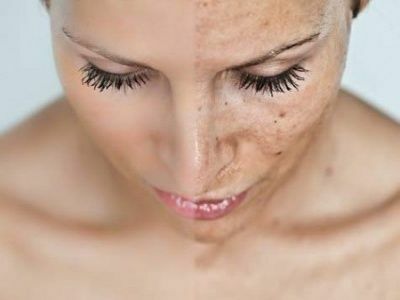Pigmented spots on the face are formed in elderly people with a light and sensitive to ultraviolet skin. As a rule, such spots are of different sizes and shapes. The main reason for their formation is a long pastime under direct sunlight.
The pigment from which the spots are composed is called melanin. It is formed and concentrated in pigment cells - melanocytes. With excess melanin in the skin there are areas of hyperpigmentation - pigmented spots.

. Causes of
- . The aging pigmentation spots on the face usually have different shades of brown, but more often they are dark. They are formed on the skin with an increase in melanin in the body of an elderly person.
Predisposing factors to the formation of age-related age spots on the face are the following:
- heredity,
- prolonged exposure to the sun,
- hypovitaminosis,
- diseases of the intestine and other digestive organs,
- aggressive skin effects of chemicals,
- improperly performed cosmetic procedures - scrubs and peelings,
- hepatic-renal pathology.
Increased age-related pigmentation is due to increased melanin synthesis in the elderly.
- Keratosis is a disease that causes a large number of pigment spots on the face. Select keratosis actinic or seborrhoeic.
- Actinic keratosis is characterized by the presence of rough, flaky skin areas, red or brown dense knots, painful to touch and easily prone to irritation. The cause of the pathology is a prolonged exposure to the open sun. Actinic keratosis is a precancer, but timely detection of the disease and properly selected treatment do not allow skin cancer to develop.
- Seborrheic keratosis is a skin disease, manifested by the presence of a huge number of moles and warts. This pathology is inherited and quite common among adults. At the same time, areas of hyperpigmentation do not pose a threat to human health. Some people prefer to remove them purely for aesthetic reasons and their own choice.
- Melasma is a disease characterized by the formation of excessive amounts of melanin in the body.
Melanodermia affects mainly women.
Factors contributing to the development of the disease are:
- hormonal imbalance,
- long-term therapy with certain drug groups,
- heredity,
- prolonged exposure to the sun.
- Hormonal factors - hormone therapy, pregnancy, contraception. Pigmented spots disappear completely after the termination of the use of hormones or after childbirth.
- Use of phototoxic drugs - tetracycline, sulfonamides, antihistamines, quinine, acne preparations. These remedies irritate the skin, make it hypersensitive to the sun. Symptoms of phototoxic photosensitivity are practically burn symptoms: the pigmentation spots on the face increase and cover most of the face, located on the nose, cheeks, forehead.
Types of pigment spots
- Freckles are small, harmless areas of darkening on the skin. Most often, such marks occur in light-skinned and fair-haired persons. This is explained by the specific rapid reaction of light skin to ultraviolet radiation.
- Lentigo is an age-related change that usually appears on the spot of freckles. They arise after forty years and bother women, because they masquerade and give out the true age.
- Chloasma or melasma - pigmented spots of large size and irregular shape, located on the face and increasing in size by merging smaller ones. In young women, chloasma appears on the temples, forehead and cheeks.
- Birthmarks or nevuses - small spots of pigmentation with clear contours. These are the so-called congenital or acquired accumulations of melanocytes. Unfavorable conditions can contribute to the malignancy of moles.
- Vitiligo is a white pigmentation spot on the face. This type is a manifestation of endocrine disorders.
Depending on the type of stains, the method of their removal is selected. In detail about what there are modern ways of fighting with them, and also what help can be rendered by folk medicine, find out from the article on the removal of pigment spots on the face.
Localization of
- The appearance of pigment spots on the face and neck occurs as a result of poisoning the body with a hydrocarbon. Most often, this affects women working in garment factories.
- A wide yellowish pigmented spot with a rim, located on the forehead, indicates the diseases of the nervous system. Only a neurologist can solve such a problem.
- Brown pigmentation spots on the face in the mouth area: on the lips and chin indicate a disruption of the normal functioning of the gastrointestinal tract.
- Slightly noticeable pigmentation spots on the face that do not have clear boundaries and periodically flaky, indicate a liver pathology. After restoring her normal work, you can permanently get rid of them.
- Pigmented spots on the face of pregnant women are called chloasma. They are the result of hormonal imbalances in the body and pass on their own after the birth.
